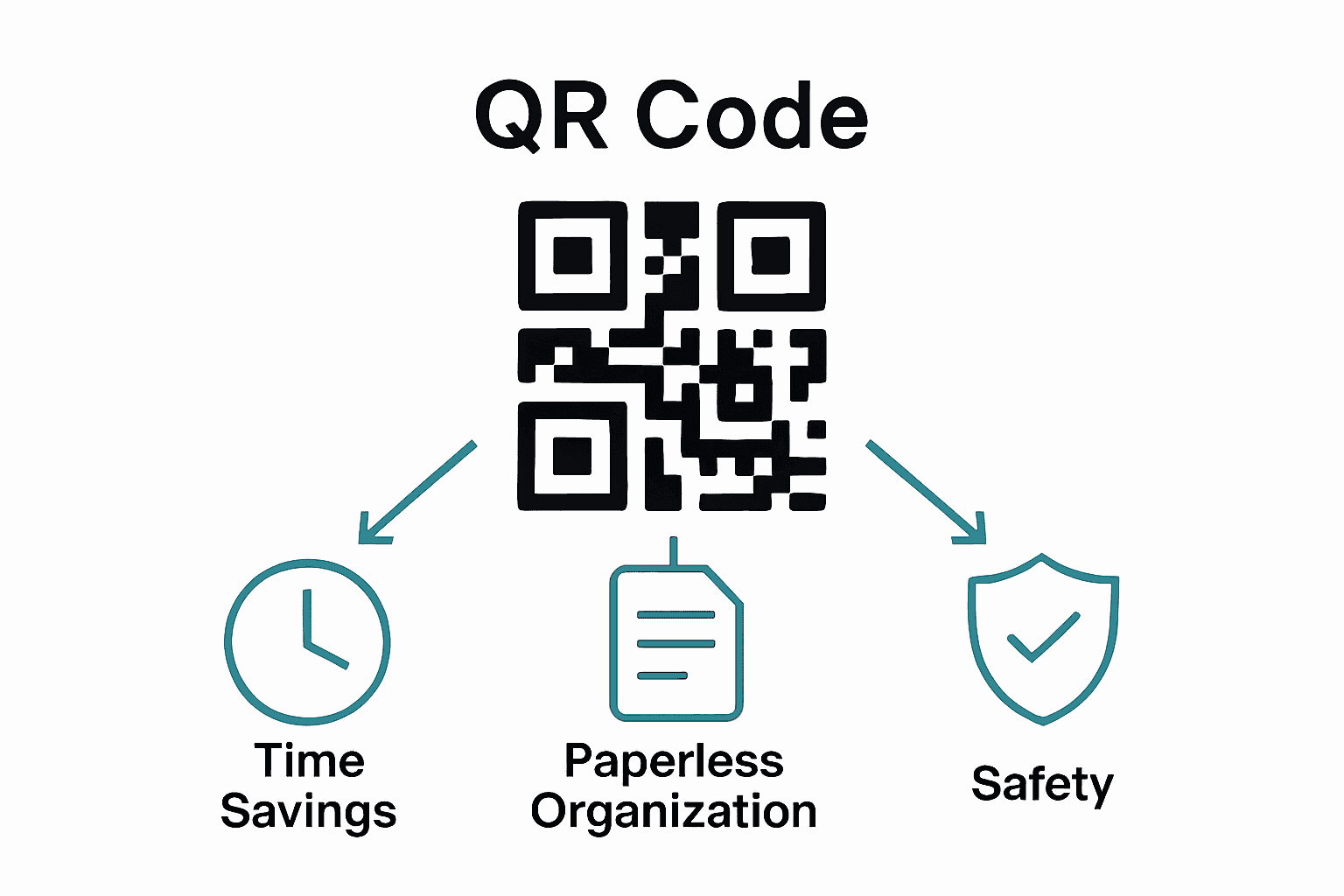How QR Codes Enhance Productivity: Complete Guide
More than half of global businesses now use QR codes to speed up daily operations, a figure that highlights just how quickly these simple squares are changing the way we work. In a world where time and efficiency matter more than ever, scanning a code can replace forms, files, and manual data entry with a single tap. Understanding how QR codes boost productivity lets you unlock smarter workflows whether for business, education, or daily life.
Table of Contents
- Definition Of QR Codes And Productivity
- Key Features Of QR Code Systems
- Popular Types And Use Cases Worldwide
- Using QR Codes For Digital Organization
- Risks, Costs, And Practical Considerations
Key Takeaways
| Point | Details |
|---|---|
| Versatility of QR Codes | QR codes serve as efficient data transfer tools, compatible with various industries for quick access to information. |
| Productivity Enhancement | Their implementation streamlines operations by reducing manual entry and improving communication across sectors. |
| Digital Organization Benefits | QR codes facilitate seamless document and resource management, transforming information access in personal and professional contexts. |
| Security and Risks | Organizations must address potential security vulnerabilities and implementation costs to leverage QR code technology effectively. |
Definition Of QR Codes And Productivity
QR codes are versatile digital tools designed to rapidly transfer information through a two-dimensional matrix barcode. Originally developed in 1994 by Masahiro Hara of Denso Wave, these compact visual markers have transformed how we access and share data across numerous industries Wikipedia.
At their core, QR codes function as efficient information bridges. They can store multiple data types including website URLs, plain text, contact details, and complex digital instructions. When scanned by a smartphone or specialized reader, these codes instantaneously redirect users to specific digital content, dramatically reducing the time and effort required to access information.
Productivity enhancement is where QR codes truly shine. According to research from Granthaalayah Publication, these innovative tools have significantly streamlined communication and information sharing across sectors like education and business. Their key productivity advantages include:
- Instant digital access
- Reduced manual data entry
- Simplified information distribution
- Enhanced tracking and documentation
- Quick connectivity between physical and digital spaces
By transforming complex information into a simple, scannable format, QR codes represent a powerful productivity tool that bridges traditional communication methods with modern digital efficiency. Whether used for inventory management, project tracking, or rapid information sharing, these smart codes are redefining how we collect, share, and process data in our increasingly connected world.
Key Features Of QR Code Systems
QR code systems represent a sophisticated technological solution with multiple embedded features that make them incredibly versatile and efficient. Wikipedia highlights their remarkable ability to encode different types of data, including numeric, alphanumeric, binary, and even kanji characters, demonstrating remarkable adaptability across various digital and physical contexts.
The technical architecture of QR code systems is designed for maximum performance and reliability. These compact visual markers incorporate advanced error correction capabilities, which means they can still be successfully scanned and decoded even if the code is partially damaged or obscured. This resilience makes them particularly valuable in challenging environments where traditional data transmission methods might fail.
According to research from Papers IAFOR, QR code systems are characterized by several key productivity-enhancing features:
- Rapid Scanning: Instantaneous information retrieval
- Paperless Operation: Environmentally friendly digital alternative
- Offline Functionality: Works without constant internet connectivity
- Easy Generation: Simple creation process for users
- Versatile Applications: Suitable for multiple industries and use cases
Understanding these core features reveals why QR codes have become such a transformative technology. Learn more about organizing with QR codes in our comprehensive guide, which provides deeper insights into maximizing their potential across personal and professional environments. Whether for inventory tracking, event management, or quick information sharing, QR code systems continue to revolutionize how we collect, store, and access critical data in our increasingly digital world.

Popular Types And Use Cases Worldwide
QR codes have rapidly evolved from a simple tracking technology to a global communication tool with diverse applications across multiple industries. Wikipedia reveals their widespread adoption in critical areas such as product tracking, item identification, time tracking, document management, and innovative marketing strategies.
The financial sector has been particularly transformative in QR code implementation. A notable example is the QR Ph system in the Philippines, which standardizes digital payment methods across various banks and electronic money platforms. This system demonstrates how QR technology can create seamless, secure transaction experiences that transcend traditional banking limitations Wikipedia.
Globally, QR codes have found remarkable applications across different sectors:
-
Retail and Inventory Management
- Product information retrieval
- Instant price comparisons
- Supply chain tracking
-
Healthcare
- Patient record management
- Medical equipment tracking
- Prescription verification
-
Education
- Interactive learning materials
- Attendance tracking
- Resource access management
-
Tourism and Hospitality
- Digital tickets and boarding passes
- Interactive museum exhibits
- Restaurant menu access
-
Marketing and Advertising
- Quick access to promotional content
- Campaign tracking
- Enhanced customer engagement
To explore more innovative approaches to organizing and utilizing QR codes, check out our comprehensive guide on organizing with QR codes. The versatility of QR technology continues to expand, promising even more sophisticated and intuitive applications in the future.

Here’s a comparative overview of key QR code applications across major industries:
| Industry | Common Use Cases | Benefits |
|---|---|---|
| Retail | Product info retrieval Price comparisons Supply chain tracking |
Faster customer service Improved inventory accuracy |
| Healthcare | Patient record management Equipment tracking Prescription verification |
Enhanced safety Streamlined operations |
| Education | Interactive materials Attendance tracking Resource access |
Engaging learning Easy resource management |
| Tourism/Hospitality | Digital tickets Exhibit guides Menu access |
Contactless experiences Visitor convenience |
| Marketing | Promo content access Campaign tracking Customer engagement |
Real-time analytics Broader reach |
Using QR Codes For Digital Organization
Digital organization has found a powerful ally in QR code technology, transforming how we manage, store, and access information across various professional and personal contexts. According to research from Granthaalayah Publication, these versatile codes are increasingly utilized in academic and scholarly environments to provide rapid access to digital content, supplementary materials, and additional resources.
In educational settings, QR codes have revolutionized administrative processes and information management. Papers IAFOR highlights their effectiveness in facilitating efficient attendance monitoring, streamlined resource sharing, and seamless access to online learning materials. This digital organization approach eliminates traditional paperwork barriers and creates more dynamic, interconnected information systems.
Practical applications of QR codes for digital organization span multiple domains:
-
Personal Document Management
- Digitize important papers
- Create quick-access document archives
- Link physical documents to cloud storage
-
Professional Workflow
- Track project documents
- Manage inventory systems
- Streamline communication protocols
-
Educational Resources
- Link study materials
- Create interactive learning portfolios
- Manage student and research records
-
Home Organization
- Tag and track personal belongings
- Create digital inventories
- Link storage containers to content lists
To explore more sophisticated approaches to digital organization, learn about QR codes in project management through our comprehensive guide. By leveraging these smart technologies, individuals and organizations can transform chaotic information landscapes into structured, easily navigable digital ecosystems.
Risks, Costs, And Practical Considerations
QR code technology, while powerful and versatile, comes with a complex landscape of potential risks and implementation challenges. Wikipedia warns that these seemingly innocent digital markers can present significant security vulnerabilities, potentially exposing users to malicious codes and phishing attempts that compromise digital safety.
Implementing QR code systems requires careful strategic planning and comprehensive risk assessment. Wikipedia emphasizes the critical considerations organizations must navigate, including compatibility across diverse devices, management costs, and robust security protocols to prevent unauthorized data access or potential breaches. These challenges demand a proactive approach to technology integration.
Key practical considerations for QR code implementation include:
-
Security Risks
- Potential malware transmission
- Phishing link vulnerabilities
- Data interception possibilities
-
Cost Factors
- Initial system setup expenses
- Ongoing maintenance requirements
- Training and implementation costs
-
Technical Compatibility
- Device scanning capabilities
- Software integration challenges
- Cross-platform functionality
-
User Privacy Concerns
- Data tracking mechanisms
- Consent and information sharing
- Potential personal information exposure
-
Mitigation Strategies
- Regular security audits
- User education programs
- Implement verification protocols
Learn more about managing QR code risks through our comprehensive business guide, which provides strategic insights into navigating the complex landscape of digital transformation. By understanding these considerations, organizations can leverage QR code technology effectively while maintaining robust security and operational integrity.
Boost Your Productivity with Smart QR Code Labels
The guide on how QR codes enhance productivity highlights common challenges like managing information efficiently, reducing manual data entry, and creating seamless connections between physical items and digital resources. If you are looking for a simple solution to organize your personal or business spaces while improving access to vital information, our QR code labels at Creative – Smack Tags are designed just for you. These durable, easy-to-use labels help you link videos, text, images, and documents to your items, eliminating clutter and paper-based frustration.

Experience the confidence that comes from knowing your storage is organized and accessible anytime without the need for complicated apps. Whether you want to create a visual inventory of keepsakes at home or streamline workflow documents at work, visit Smack Tags today to get started. Take action now and transform how you manage information with our reliable QR code labels that come with an affordable subscription to keep your data safe and accessible.
Frequently Asked Questions
What are QR codes and how do they enhance productivity?
QR codes are two-dimensional barcodes that quickly transfer information when scanned. They enhance productivity by providing instant access to digital content, reducing manual data entry, and simplifying information distribution across various sectors.
What are the key features of QR code systems?
Key features of QR code systems include rapid scanning for instant information retrieval, error correction capabilities, offline functionality, easy generation, and their versatility across multiple industries and applications.
In which industries are QR codes commonly used?
QR codes are used across various industries, including retail for inventory management, healthcare for patient record management, education for interactive learning, tourism for digital ticketing, and marketing for promotional campaigns.
What risks should be considered when implementing QR codes?
When implementing QR codes, organizations should consider security risks like malware transmission, user privacy concerns, compatibility across devices, and the associated costs of establishment and maintenance. Regular security audits and user education can mitigate these risks.
Recommended
- Complete Guide to Information Access via QR Codes – Smack Tags
- Role of QR Codes in Business: Complete Guide – Smack Tags
- Complete Guide to Organizing With QR Codes – Smack Tags
- Ideas and Education – Smack Tags
- QR-Codes, Barcodes, DMC, UDI und lpn-Codes | justlaser.com
- 7 Effective Employee Engagement Ideas for Managers – Blog
